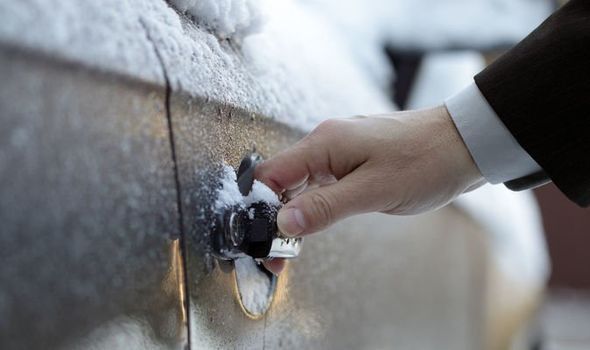Dealing with a frozen door lock
Addressing the common issue of dealing with frozen door locks.
As experts in the field of security, we understand the frustration and inconvenience that comes with dealing with frozen door locks, especially during the cold winter months. Whether it's your car, residential, or commercial property, a frozen lock can pose significant challenges and hinder your daily routine. That's why it's crucial to have a comprehensive understanding of the various solutions available to address this common issue.
In this blog post, we'll explore the different techniques and methods for dealing with frozen door locks, tailored to specific scenarios. From the icy grip of your car door in the morning to the frozen locks of your home or business, we'll provide expert insights and practical tips to help you navigate through these situations effectively.
By delving into the specific solutions for car, residential, and commercial frozen door locks, we aim to equip you with the knowledge and tools necessary to tackle this problem with confidence. Whether it's using de-icing sprays, applying heat carefully, or seeking professional locksmith assistance, we'll cover it all. So, let's dive in and discover how to thaw out those frozen locks and regain access to your property swiftly and safely.
Read more about de-icing sprays -How they work!
Understanding Frozen Door Locks
Causes of Freezing
Door locks freeze primarily due to moisture buildup, low temperatures, or mechanical issues. When moisture seeps into the lock mechanism and freezes, it can prevent the key from turning or the lock from disengaging. Additionally, extremely low temperatures can cause the metal components of the lock to contract, making it difficult to operate. Mechanical issues, such as worn-out parts or inadequate lubrication, can also contribute to freezing.
Read more about Top door lock brands!
Types of Locks Affected
Frozen door locks can affect various types of locks, including car, residential, and commercial locks. Car door locks are often exposed to the elements and can freeze due to external moisture and low temperatures. Residential door locks, especially those on exterior doors, can also freeze, particularly during cold weather conditions. Commercial door locks, such as those on storefronts or office buildings, are not immune to freezing and may experience similar issues. It's essential to address frozen locks promptly to ensure continued access to vehicles, homes, and businesses.
Solutions for Car Frozen Door Locks
- Use De-Icer Spray: De-icer spray is specifically designed to melt ice and frost on car windows and locks. Apply the de-icer directly to the frozen lock mechanism according to the manufacturer's instructions. The solution will quickly dissolve the ice, allowing you to insert the key and unlock the door.
- Heat the Key: If you don't have de-icer spray on hand, heating the key with a lighter or match can help thaw the ice in the lock. Carefully heat the key until it's warm to the touch, then insert it into the lock and gently wiggle it to loosen the ice. Repeat the process as needed until the lock is unfrozen.
- Rubbing Alcohol: Rubbing alcohol has a lower freezing point than water, making it effective for melting ice in door locks. Apply a small amount of rubbing alcohol to a cotton swab or cloth and rub it on the frozen lock mechanism. The alcohol will dissolve the ice and evaporate quickly, leaving the lock unfrozen.
- Warm Water: Warm water can also be used to melt ice in car door locks. Pour lukewarm water over the frozen lock mechanism, being careful not to use water that is too hot, as it could damage the lock or surrounding paint. Once the ice has melted, try unlocking the door with the key.
- Hair Dryer: If you have access to a power source, using a hair dryer on the lowest heat setting can help thaw a frozen car door lock. Hold the hair dryer close to the lock mechanism and move it around to evenly distribute the heat. After a few minutes, attempt to unlock the door with the key.

Solutions for Residential Frozen Door Locks
- Use a Hair Dryer: Similar to car door locks, a hair dryer can be effective in thawing frozen residential door locks. Set the hair dryer to a low heat setting and direct the warm air onto the lock mechanism. Move the hair dryer around to evenly distribute the heat and melt the ice. Once the lock is unfrozen, insert the key and turn it to unlock the door.
- Apply De-Icer Spray: De-icer spray can also be used to thaw frozen residential door locks. Spray the de-icer directly onto the lock mechanism and wait a few moments for it to dissolve the ice. Use a cloth or paper towel to wipe away any excess moisture, then insert the key and turn it to unlock the door.
- Use a Heat Gun: If you have access to a heat gun, it can be an effective tool for quickly thawing frozen door locks. Set the heat gun to a low or medium heat setting and carefully aim it at the lock mechanism. Move the heat gun around to evenly heat the area and melt the ice. Once the lock is unfrozen, insert the key and turn it to open the door.
- Apply WD-40 or Graphite Lubricant: WD-40 or graphite lubricant can help prevent future freezing and provide temporary relief for frozen locks. Spray WD-40 or apply graphite lubricant directly into the keyhole and around the lock mechanism. Use the key to work the lubricant into the lock, which can help loosen any ice or debris causing the blockage.
- Warm Key or Ice Melt Pellets: If you don't have access to specialized products, you can try warming the key with a lighter or match before inserting it into the lock. Alternatively, you can use ice melt pellets or rock salt to dissolve the ice around the lock. Sprinkle the pellets or salt around the base of the lock and wait for them to melt the ice before attempting to unlock the door.

Solutions for Commercial Frozen Door Locks
- Heat Source: Use a portable heat source, such as a heat gun or blowtorch, to warm up the frozen lock. Apply heat to the lock mechanism from a safe distance to avoid damaging surrounding materials. Once the ice has melted, use a key or lock pick to unlock the door.
- De-Icing Solution: Apply a commercial de-icing solution to the frozen lock. These solutions typically contain chemicals that can quickly melt ice and snow. Follow the manufacturer's instructions for safe and effective application. After applying the de-icer, use a key or lock pick to unlock the door.
- Hot Water: Pour hot water over the frozen lock to melt the ice. Be cautious not to use boiling water, as it can damage the lock or surrounding materials. Use warm water instead and pour it directly onto the lock mechanism. Once the ice has melted, use a key or lock pick to open the door.
- Lock Lubricant: Apply a lock lubricant, such as WD-40 or graphite powder, to the frozen lock. These lubricants can help loosen the ice and prevent future freezing. Spray the lubricant directly into the keyhole and around the lock mechanism. Use a key or lock pick to work the lubricant into the lock and open the door.
- Professional Assistance: If the above methods fail to thaw the frozen lock, consider seeking professional locksmith assistance. Locksmiths have specialized tools and techniques to safely and effectively thaw frozen locks without causing damage. Contact a reputable locksmith service to assess and resolve the issue promptly.
Preventive Measures
To prevent future occurrences of frozen door locks, consider implementing the following preventive measures:
- Protective Covering: Install a weatherproof cover or shield over outdoor locks to shield them from snow, ice, and moisture. This can help minimize the likelihood of locks freezing during cold weather.
- Lock De-Icer: Keep a bottle of lock de-icer handy for quick thawing of frozen locks. Regularly apply the de-icer to locks during cold weather to prevent ice buildup.
- Regular Lubrication: Maintain locks with regular lubrication to keep them functioning smoothly. Apply a lock lubricant, such as graphite powder or silicone spray, to keyholes and lock mechanisms to prevent moisture from accumulating and freezing.
- Door Sealing: Ensure that doors are properly sealed to prevent drafts and moisture infiltration, which can contribute to freezing. Replace worn weather stripping and caulking around doors to create a tight seal.
- Heating Solutions: Install outdoor heating solutions, such as heat lamps or electric heating cables, near door locks to provide continuous warmth and prevent freezing. These heating elements can be controlled by timers or thermostats to activate when temperatures drop.
- Insulation: Improve the insulation around doors and locks to maintain warmer temperatures and reduce the risk of freezing. Consider adding insulation to door frames, installing thermal curtains, or upgrading to insulated doors.
By implementing these preventive measures, you can minimize the occurrence of frozen door locks and ensure continued access to your property during cold weather conditions. Regular maintenance and proactive steps can help safeguard against the inconvenience and potential damage caused by frozen locks.
Read more about Importance of regular lock maintenance!
Conclusion:
In conclusion, dealing with frozen door locks can be a frustrating and inconvenient experience, especially during cold weather. However, by understanding the causes of freezing and implementing appropriate solutions, you can effectively address this issue for car, residential, and commercial locks alike.
Whether it's using de-icers, applying lubricants, or installing protective coverings, there are various methods available to thaw frozen locks and prevent future occurrences. Additionally, taking preventive measures such as regular maintenance, insulation, and heating solutions can help mitigate the risk of locks freezing in the first place.
By following these strategies and staying proactive, you can ensure that your door locks remain functional and accessible, even in the coldest of temperatures. Don't let frozen locks leave you out in the cold – take action to protect your property and maintain peace of mind year-round.
Call Us Any Time!




